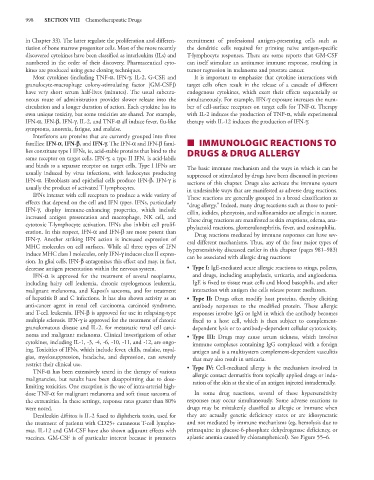Page 1012 - Basic _ Clinical Pharmacology ( PDFDrive )
P. 1012
998 SECTION VIII Chemotherapeutic Drugs
in Chapter 33). The latter regulate the proliferation and differen- recruitment of professional antigen-presenting cells such as
tiation of bone marrow progenitor cells. Most of the more recently the dendritic cells required for priming naive antigen-specific
discovered cytokines have been classified as interleukins (ILs) and T-lymphocyte responses. There are some reports that GM-CSF
numbered in the order of their discovery. Pharmaceutical cyto- can itself stimulate an antitumor immune response, resulting in
kines are produced using gene cloning techniques. tumor regression in melanoma and prostate cancer.
Most cytokines (including TNF-α, IFN-γ, IL-2, G-CSF, and It is important to emphasize that cytokine interactions with
granulocyte-macrophage colony-stimulating factor [GM-CSF]) target cells often result in the release of a cascade of different
have very short serum half-lives (minutes). The usual subcuta- endogenous cytokines, which exert their effects sequentially or
neous route of administration provides slower release into the simultaneously. For example, IFN-γ exposure increases the num-
circulation and a longer duration of action. Each cytokine has its ber of cell-surface receptors on target cells for TNF-α. Therapy
own unique toxicity, but some toxicities are shared. For example, with IL-2 induces the production of TNF-α, while experimental
IFN-α, IFN-β, IFN-γ, IL-2, and TNF-α all induce fever, flu-like therapy with IL-12 induces the production of IFN-γ.
symptoms, anorexia, fatigue, and malaise.
Interferons are proteins that are currently grouped into three
families: IFN-`, IFN-a, and IFN-f. The IFN-α and IFN-β fami- ■ IMMUNOLOGIC REACTIONS TO
lies constitute type I IFNs, ie, acid-stable proteins that bind to the DRUGS & DRUG ALLERGY
same receptor on target cells. IFN-γ, a type II IFN, is acid-labile
and binds to a separate receptor on target cells. Type I IFNs are The basic immune mechanism and the ways in which it can be
usually induced by virus infections, with leukocytes producing suppressed or stimulated by drugs have been discussed in previous
IFN-α. Fibroblasts and epithelial cells produce IFN-β. IFN-γ is sections of this chapter. Drugs also activate the immune system
usually the product of activated T lymphocytes. in undesirable ways that are manifested as adverse drug reactions.
IFNs interact with cell receptors to produce a wide variety of These reactions are generally grouped in a broad classification as
effects that depend on the cell and IFN types. IFNs, particularly “drug allergy.” Indeed, many drug reactions such as those to peni-
IFN-γ, display immune-enhancing properties, which include cillin, iodides, phenytoin, and sulfonamides are allergic in nature.
increased antigen presentation and macrophage, NK cell, and These drug reactions are manifested as skin eruptions, edema, ana-
cytotoxic T-lymphocyte activation. IFNs also inhibit cell prolif- phylactoid reactions, glomerulonephritis, fever, and eosinophilia.
eration. In this respect, IFN-α and IFN-β are more potent than Drug reactions mediated by immune responses can have sev-
IFN-γ. Another striking IFN action is increased expression of eral different mechanisms. Thus, any of the four major types of
MHC molecules on cell surfaces. While all three types of IFN hypersensitivity discussed earlier in this chapter (pages 981–983)
induce MHC class I molecules, only IFN-γ induces class II expres- can be associated with allergic drug reactions:
sion. In glial cells, IFN-β antagonizes this effect and may, in fact,
decrease antigen presentation within the nervous system. • Type I: IgE-mediated acute allergic reactions to stings, pollens,
IFN-α is approved for the treatment of several neoplasms, and drugs, including anaphylaxis, urticaria, and angioedema.
including hairy cell leukemia, chronic myelogenous leukemia, IgE is fixed to tissue mast cells and blood basophils, and after
malignant melanoma, and Kaposi’s sarcoma, and for treatment interaction with antigen the cells release potent mediators.
of hepatitis B and C infections. It has also shown activity as an • Type II: Drugs often modify host proteins, thereby eliciting
anti-cancer agent in renal cell carcinoma, carcinoid syndrome, antibody responses to the modified protein. These allergic
and T-cell leukemia. IFN-β is approved for use in relapsing-type responses involve IgG or IgM in which the antibody becomes
multiple sclerosis. IFN-γ is approved for the treatment of chronic fixed to a host cell, which is then subject to complement-
granulomatous disease and IL-2, for metastatic renal cell carci- dependent lysis or to antibody-dependent cellular cytotoxicity.
noma and malignant melanoma. Clinical investigations of other • Type III: Drugs may cause serum sickness, which involves
cytokines, including IL-1, -3, -4, -6, -10, -11, and -12, are ongo- immune complexes containing IgG complexed with a foreign
ing. Toxicities of IFNs, which include fever, chills, malaise, myal- antigen and is a multisystem complement-dependent vasculitis
gias, myelosuppression, headache, and depression, can severely that may also result in urticaria.
restrict their clinical use. • Type IV: Cell-mediated allergy is the mechanism involved in
TNF-α has been extensively tested in the therapy of various
malignancies, but results have been disappointing due to dose- allergic contact dermatitis from topically applied drugs or indu-
ration of the skin at the site of an antigen injected intradermally.
limiting toxicities. One exception is the use of intra-arterial high-
dose TNF-α for malignant melanoma and soft tissue sarcoma of In some drug reactions, several of these hypersensitivity
the extremities. In these settings, response rates greater than 80% responses may occur simultaneously. Some adverse reactions to
were noted. drugs may be mistakenly classified as allergic or immune when
Denileukin diftitox is IL-2 fused to diphtheria toxin, used for they are actually genetic deficiency states or are idiosyncratic
the treatment of patients with CD25+ cutaneous T-cell lympho- and not mediated by immune mechanisms (eg, hemolysis due to
mas. IL-12 and GM-CSF have also shown adjuvant effects with primaquine in glucose-6-phosphate dehydrogenase deficiency, or
vaccines. GM-CSF is of particular interest because it promotes aplastic anemia caused by chloramphenicol). See Figure 55–6.

